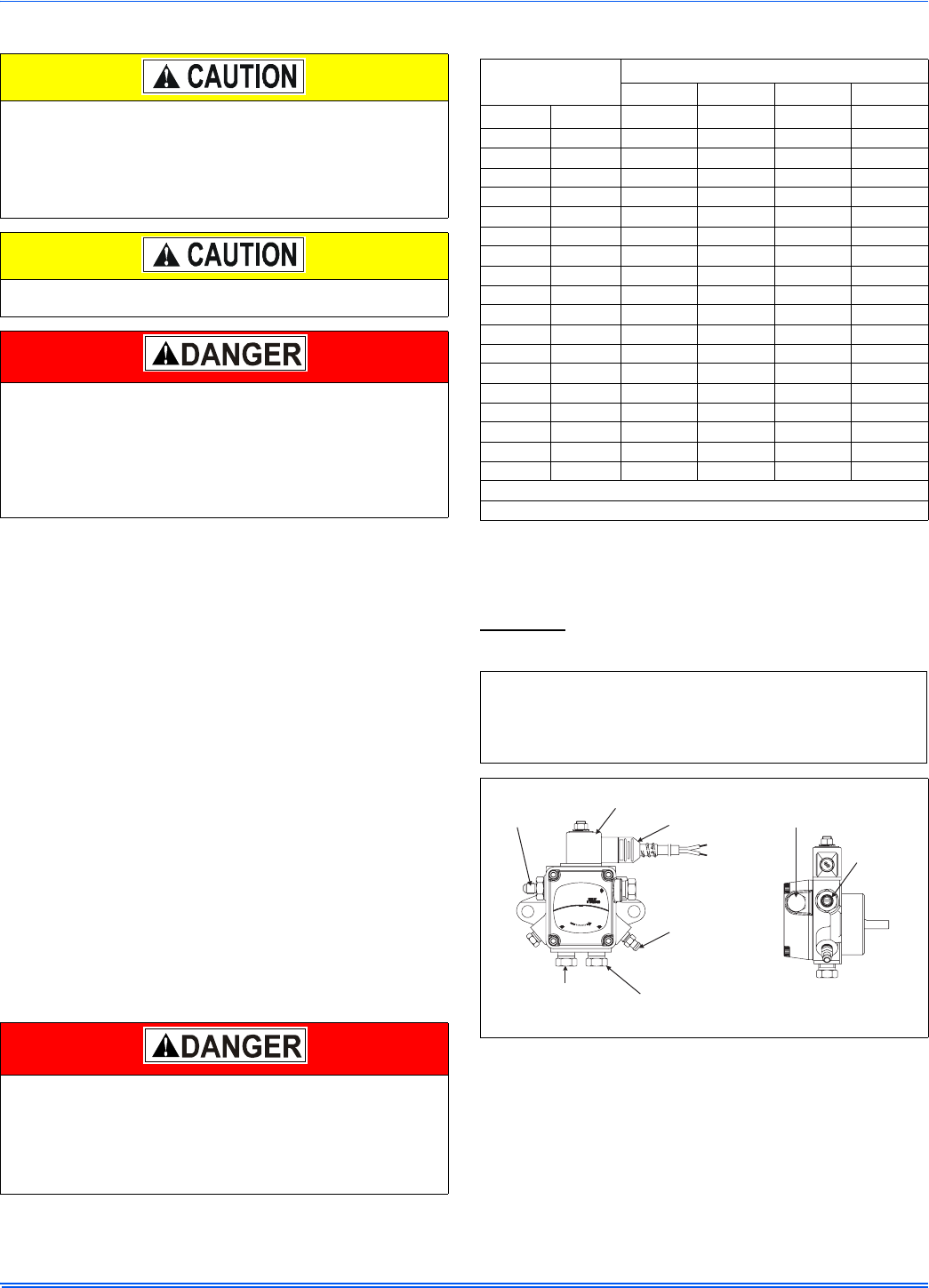
107272-UIM-B-1105
12 Unitary Products Group
NOTICE SPECIAL REQUIREMENTS
THE EFFECT OF ELEVATION ON OIL BURNER
FIRING
The elevation of the installation of a modern high-speed flame retention
oil burner affects the performance of the burner. Allowance for elevation
must be taken into consideration when choosing an oil burner and oper-
ating it above 2000 ft. (610m).
It is especially important in high elevation installations to adjust air set-
tings to match the burner nozzle firing rate. As elevation increases
above sea level, the ambient air contains less oxygen. Because there is
less available oxygen per cubic foot of air, the burner must deliver a
greater volume flow (cfm) of air to provide the proper amount of oxygen
for the amount of oil being burned. This is the reason that an increase in
the burner air setting may be required.
It is also important in high elevation installations to consider the maxi-
mum firing rate of the burner, so that the heat input as required by the
application is maintained. Regardless of elevation, the oil burner has a
maximum volume flow of air that it can deliver. As a result, the maxi-
mum firing rate of the oil burner decreases as the elevation increases,
because the combustion air contains less oxygen. An increase in the
size of a fixed-type retention head, or even the use of an oil burner with
a higher maximum firing rate may be necessary.
The effect of elevation up to 2000 ft. (610 m) is minimal, so no re-rate is
necessary up to 2000 ft. (610 m) elevation. Above 2000 ft. (610 m), for
every 1000 ft. (305 m) above sea level (including the first 2000 ft. (610
m), there is a 1.84% rate reduction of the burner. To assist you, we have
included the following chart and some examples: Refer to Table 7.
ft = feet
m = meters
gph = gallons per hour
l/h = liters per hour
EXAMPLE 1:
.
INSTALLATION AND CHECKING OF OIL PIPING
Location and installation of oil tanks and oil piping must comply with
local codes and regulations. In absence of such codes, follow NFPA 31:
Standard Floor Installation of Oil Burner Equipment.
This equipment must be installed, adjusted, and started only by a
qualified service technician, an individual or agency, licensed and
experienced with all codes and ordinances, who is responsible for
the installation and adjustment of the equipment. The installation
must comply with all local codes and ordinances and with the
National Fire Protection Standard for Liquid Fuel Equipment, NFPA
31 (or in Canada the installation must comply with CSA B139).
This pump must be used with a control system that provides a valve
on delay (pre-purge).
This furnace is designed to operate on #1 FUEL-OIL or #2 FUEL-
OIL ONLY. Do Not burn any other fuel in this furnace. Burning any
fuel except #1 FUEL-OIL or #2 FUEL-OIL in this furnace can cause
premature heat exchanger burnout, high levels of carbon monox-
ide, excessive sooting, a fire hazard, personal injury, property dam-
age, and/or death.
In Canada, the furnace is designed to operate on #1 STOVE OIL or
#2 FURNACE OIL ONLY.
The pressure regulator on the fuel pump must not be adjusted in
excess of 100 PSIG (689 kPa).
Pressures exceeding 100 PSIG (689 kPa) may cause an overheat-
ing condition which can lead to premature heat exchanger failure,
resulting in a fire or explosion, or cause damage to the furnace of
some of its components that will result in property damage and loss
of life. Refer to Figure 16 for Pressure Regulator Location.
TABLE 7:
Burner Rating at Elevation Above Sea Level, gph (l/m)
Elevation
(Above Sea Level)
Nozzle Size
0.50 1.892706 0.65 2.460518
ft m gph l/h gph l/h
500 152 0.50 1.89 0.65 2.46
1,000 305 0.50 1.89 0.65 2.46
1,500 457 0.50 1.89 0.65 2.46
2,000 610 0.50 1.89 0.65 2.46
2,500 762 0.49 1.86 0.65 2.46
3,000 914 0.48 1.82 0.64 2.42
3,500 1,067 0.48 1.82 0.64 2.42
4,000 1,219 0.47 1.79 0.63 2.37
4,500 1,372 0.47 1.79 0.63 2.37
5,000 1,527 0.46 1.76 0.61 2.33
5,500 1,676 0.46 1.76 0.61 2.33
6,000 1,829 0.46 1.72 0.60 2.28
6,500 1,981 0.46 1.72 0.60 2.28
7,000 2,134 0.45 1.69 0.59 2.24
7,500 2,286 0.45 1.69 0.59 2.24
8,000 2,438 0.44 1.66 0.58 2.20
9,000 2,743 0.43 1.63 0.57 2.16
10,000 3,048 0.42 1.60 0.56 2.12
Note: All examples are for 7000 ft. elevation.
1.84% x 7 (for 7000 ft.) = 12.9% → 100% - 12.9% = 87.1%
Re-Rating of the Maximum Firing Rate for Burners @ 7000 ft.
Burner
Model
Maximum Firing
Rate of Burner
@ Sea Level
X
Elevation
Re-rate Factor
@ 7000 ft.
=
Adjusted
Maximum
Firing Rate
AFG 3.00 gph (11.4 L/h) X 87.1% = 2.61 gph (9.83 Lh)
AF 3.00 gph (11.4 L/h) X 87.1% = 2.61 gph (9.83 Lh)
FIGURE 16: Oil Pump
4 GPH100-150 PSI3450 RPM
3 GPH150-200 PSI3450 RPM
NO. 2 & LIGHTER FUEL
INLET
BY-PASS
Exclusively for Beckett
Made by Suntec
INLET
NO. 2FUEL
A2EA-6520
Beckett
CLEANCUT
USEONLYWITH
VALVEONDELAY
Pressure
Adjustment
Screw
Inlet Port
1/4 NPTF
Bleed &
Gauge Port
Return Port
Install 1/16” by Pass Pipe
Plug For Two-Pipe System Only
(Use 5/32” Allen Wrench)
Cordset
By Pass
Solenoid
Valve
Inlet Port
1/4 NPTF
(0.64 cm)
Nozzle Port
3/16 Flare
Fittting
